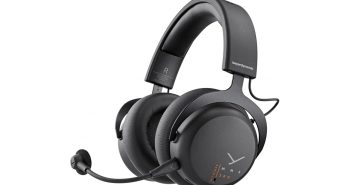Serious gamers often spend obscene amounts of money on upgrading their PCs with the intention of getting the most performance possible. One area which is often over-looked is the disk drive. In recent times, the 7,200 RPM drive has become the standard however some gamers are spending the extra cash for higher-performance 10,000 RPM drives. These more expensive drives, however, do not come in high capacities yet and still use draconian platter-based storage methodology. Enter the solid-state disk (SSD). With no moving parts and similar capacities to 10,000 RPM platter-based disks, the SSD offers even better transfer rates, albeit at a higher price tag.
Samsung’s latest consumer SSD is the PM800 available in 64, 128, and now 256GB capacities. The model we got to look at was in the 2.5” form factor and features a 3.0gb SATA connector and power port. It features a brushed aluminum face plate and has a very sleek, industrial design. Also something to note is that the drive weighs practically nothing at 80 grams. Physically, the SSD beats out any platter-based drive. However, what about the performance?
Our test rig is setup like so…
CPU – Intel 2.66GHz i7
GPU – Nvidia GTX-280
RAM – 6GB DDR3
MB – EVGA x58 SLI
Chassis – Antec Skeleton
HDD – Hitachi 7,200 RPM 1TB Drive
We added the Samsung SSD to our system and began several tests running it through the motions. Our tests consisted of timing the various loading processes of three different video games: Crysis, Brothers in Arms: Hell’s Highway, and Oblivion. All times are in (minutes.seconds) format. Times were rounded to the nearest second. No cutscenes or videos were skipped in the testing process.
CRYSIS
With Samsung SSD
Exe launch to menu – 1.02
First level loading – 0.22
With 7,200 RPM Drive
Exe launch to menu – 1.10
First level loading – 0.28
As you can see, the SSD yielded an average decrease in loading times by an average of 7 seconds.
BROTHERS IN ARMS: HELL’S HIGHWAY
With Samsung SSD
Exe launch to menu – 0.32
First level loading – 3.23
With 7,200 RPM Drive
Exe launch to menu – 0.40
First level loading – 3.26
In the case of BiA:HH, the Samsung SSD again yielded an average decrease in loading times of 7 seconds.
OBLIVION
With Samsung SSD
Exe launch to menu – 0.47
First level loading (to initial character creation) – 2.0
With 7,200 RPM Drive
Exe launch to menu – 0.48
First level loading (to initial character creation) – 2.03
The loading time decrease was not as apparent in Oblivion, with the Samsung SSD yielding only a 1.5 second average decrease.

Overall, the Samsung SSD gave good decreases in load times over the more traditional 7,200 RPM hard disk drive. Also, when copying files back and forth on the drive – and deleting large amounts of files off of the drive, the SSD just screams. Obviously, many people would purchase the drive and use it as a primary OS disk but for our purposes we looked at the product from the standpoint of a gamer looking to add a secondary gaming drive on their PC.
For some odd reason, you will find when looking for other reviews on the drive that the reviewer will often compare it to a 5,400 RPM disk. This is because Samsung highly-touts the SSD for use in notebook gaming PCs. However, in our testing we clearly saw that the drive outperforms even 7,200 RPM disks. We were unable to procure a 10,000 RPM disk for comparison, although we would assume it would hold its own in that test too.
The biggest drawback for the SSD at this point is its price. Samsung is mainly selling their 256GB SSD as an OEM part right now but, when found in the consumer market it retails for at least $500 dollars. Now, when compared to other drives in the same range that is not anything above average. However, when looked at next to a platter-based disk you definitely still get more megabytes per dollar than with the solid-state drives.
Overall, gamers looking for the best disk performance possible along with high reliability as well as physical space-saving would be remiss not to choose the Samsung SSD as their primary OS disk or a dedicated, secondary gaming drive.
You can find the rundown on Samsung’s whole line of SSDs at their official SSD website.
Here is the video companion to this review, taken on my Creative Vado – but please note it was shot before we rounded the results to the nearest second.




